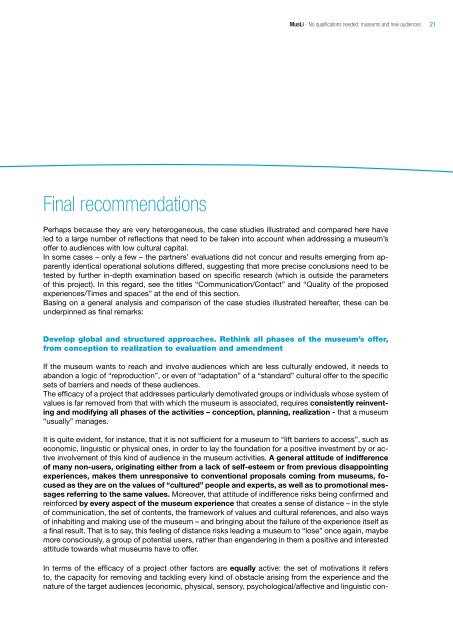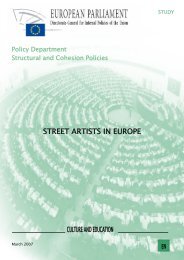MusLi (Museums Literacy) - Fondazione Fitzcarraldo
MusLi (Museums Literacy) - Fondazione Fitzcarraldo
MusLi (Museums Literacy) - Fondazione Fitzcarraldo
You also want an ePaper? Increase the reach of your titles
YUMPU automatically turns print PDFs into web optimized ePapers that Google loves.
Final recommendations<br />
<strong>MusLi</strong> - No qualifications needed: museums and new audiences<br />
Perhaps because they are very heterogeneous, the case studies illustrated and compared here have<br />
led to a large number of reflections that need to be taken into account when addressing a museum’s<br />
offer to audiences with low cultural capital.<br />
In some cases – only a few – the partners’ evaluations did not concur and results emerging from apparently<br />
identical operational solutions differed, suggesting that more precise conclusions need to be<br />
tested by further in-depth examination based on specific research (which is outside the parameters<br />
of this project). In this regard, see the titles “Communication/Contact” and “Quality of the proposed<br />
experiences/Times and spaces” at the end of this section.<br />
Basing on a general analysis and comparison of the case studies illustrated hereafter, these can be<br />
underpinned as final remarks:<br />
Develop global and structured approaches. Rethink all phases of the museum’s offer,<br />
from conception to realization to evaluation and amendment<br />
If the museum wants to reach and involve audiences which are less culturally endowed, it needs to<br />
abandon a logic of “reproduction”, or even of “adaptation” of a “standard” cultural offer to the specific<br />
sets of barriers and needs of these audiences.<br />
The efficacy of a project that addresses particularly demotivated groups or individuals whose system of<br />
values is far removed from that with which the museum is associated, requires consistently reinventing<br />
and modifying all phases of the activities – conception, planning, realization - that a museum<br />
“usually” manages.<br />
It is quite evident, for instance, that it is not sufficient for a museum to “lift barriers to access”, such as<br />
economic, linguistic or physical ones, in order to lay the foundation for a positive investment by or active<br />
involvement of this kind of audience in the museum activities. A general attitude of indifference<br />
of many non-users, originating either from a lack of self-esteem or from previous disappointing<br />
experiences, makes them unresponsive to conventional proposals coming from museums, focused<br />
as they are on the values of “cultured” people and experts, as well as to promotional messages<br />
referring to the same values. Moreover, that attitude of indifference risks being confirmed and<br />
reinforced by every aspect of the museum experience that creates a sense of distance – in the style<br />
of communication, the set of contents, the framework of values and cultural references, and also ways<br />
of inhabiting and making use of the museum – and bringing about the failure of the experience itself as<br />
a final result. That is to say, this feeling of distance risks leading a museum to “lose” once again, maybe<br />
more consciously, a group of potential users, rather than engendering in them a positive and interested<br />
attitude towards what museums have to offer.<br />
In terms of the efficacy of a project other factors are equally active: the set of motivations it refers<br />
to, the capacity for removing and tackling every kind of obstacle arising from the experience and the<br />
nature of the target audiences (economic, physical, sensory, psychological/affective and linguistic con-<br />
21






